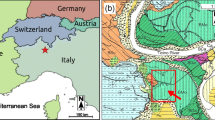Abstract
Because of the inherent multi-scale heterogeneity of porous media and the limitation of single-subject observed data, we propose to combine deterministic and stochastic techniques to simulate heterogeneity. We select a coastal plain sediment system as an example to demonstrate and verify this approach. Firstly, we apply transition probability matrix to determine and delineate the nonstationary unconformity, and combine hydro-stratigraphy analyses to establish the field/large-scale, deterministic stratigraphy model. Secondly, we apply fence diagrams and CPT data to infer the horizontal mean length of hydrofacies, and then build Markov chain models for each depositional system and simulate the local/intermediate-scale, stochastic hydrofacies model. Finally, we combine the stratigraphy and hydrofacies models to get a multi-scale heterogeneous model embedded with quantitative and qualitative observed data, with both deterministic and stochastic characteristics. In order to study the influence of uncertainty in model parameters on solute transport, we build multiple realizations of two types of heterogenous model and use them to simulate groundwater flow and solute transport. The parameter sensitivity analysis shows the 1st and 2nd spatial moments of the contaminant plume increase with the lateral average length of hydrofacies.
Similar content being viewed by others
References
Wood, W. W., It’s the heterogeneity, Ground Water, 2000, 38(1): 1–10.
Koltermann, C. E., Gorelick, S. M., Heterogeneity in sedimentary deposits: A review of structure-imitating, process-imitating, and descriptive approaches, Water Resources Research, 1996, 32: 2617–2658.
Scheibe, T. D., Freyberg, D. L., The use of sedimentological information for geometric simulation of natural porous media structure, Water Resources Research, 1995, 31(12): 3259–3270.
Fogg, G. E., Groundwater flow and sand body interconnectedness in a thick multiple aquifer system. Water Resources Research, 1986, 22(5): 679–694.
Koltermann, C. E., Gorelick, S. M., Paleoclimate signature in terrestrial flood deposits, Science, 1992, 256: 1775–1782.
Webb, E. K., Anderson, M. P., Simulation of preferential flow in three-dimensional heterogenous conductivity fields with realistic internal architecture, Water Resources Research, 1996, 32(3): 533–545.
Marsily, G. de, Delay, F., Teles, V. et al., Some current methods to represent the heterogeneity of natural media in hydrogeology, Hydrogeology Journal, 1998, 6: 115–130.
Weissmann, G. S., Carle, S. F., Fogg, G. E., Three-dimensional hydrofacies modeling based on soil surveys and transition probability geostatistics, Water Resources Research, 1999, 35(6): 1761–1770.
Dagan, G., Flow and Transport in Porous Formations, Berlin: Springer-Verlag, 1989, 15–17.
Miller, R. B., Castle, J. W., Temples, T. J., Deterministic and stochastic modeling of aquifer stratigraphy, South Carolina, Ground Water, 2000, 38(2): 284–295.
Carle, S. F., Fogg, G. E., Modeling spatial variability with one- and multi-dimensional continuous Markov chains, Mathematical Geology, 1997, 29(7): 891–918.
Zhang, Y., Weissmann, G. S., Fogg, G. E. et al., Effect of multi-scale heterogeneity on predictive uncertainty and groundwater age dates (abst.), AGU Annual Fall Meeting EOS Abstracts Volume, 2000, F434.
Weissmann, G. S., Zhang, Y., LaBolle, E. M. et al., Modeling environmental tracer-based groundwater ages in heterogeneous aquifers, Water Resources Research, to be published.
Carle, S. F., Fogg, G. E., Transition probability-based indicator geostatistics, Mathematical Geology, 1996, 28(4): 453–476.
Poeter, E. P., McKenna, S. A., Field example of data fusion in site characterization. Water Resources Research, 1995, 31(12): 3229–3240.
Liu Jiakun, Applied Random Process, Beijing: Science Press, 2000, 105–107.
Elfeki, A., Dekking, M., A Markov chain model for subsurface characterization: Theory and applications, Mathematical Geology, 2001, 33(5): 569–589.
Aadland, R. K., Gellici, J. A., Thayer, P. A., Hydrogeologic framework of west-central south Carolina. Water Resources Division Reports, 1995, 1–200.
Wyatt, D. E., Harris, M. K. eds., Carolina Geological Society, 2000 Field Trip Guildbook: Savannah River Site Environmental Remediation Systems in Unconsolidated Upper Coastal Plain Sediments — Stratigraphic and Structure Considerations, Aiken: Carolina Geological Society, 2000.
Weissmann, G. S., Fogg, G. E., Muitl-sale alluvial fan heterogeneity modeled with transition probability geostatistics in a sequence stratigraphic framework, Journal of Hydrology, 1999, 226(1–2): 48–65.
Hutchinson, M. F., Development of a Continent-wide DEM with Applications to Terrain and Climate Analysis, Environmental Modeling with GIS (ed. Goodchild, M. F.): New York: Oxford University Press, 1993, 392–399.
Frank, H. S., Douglas, E. W., Greg, P. F., Methodology and interpretation of the piezocone penetrometer test sounding for estimating soil character and stratigraphy at the Savannah River site, in Carolina Geological Society 2000 Field Trip Guidebook, 2000, c1–c10.
Carle, S. F., A transition probability-based approach to geostatistical characterization of hydrostratigraphic architecture, PH.D. Dissertation, Berkeley: University of California, 1996, 58.
Norberg, T., Rosen, L., Baran, A. et al., On modeling discrete geological structures as Markov random fields, Mathematical Geology, 2002, 34(1): 63–77.
Maidment, D. R., Handbook of Hydrology, New York: McGraw-Hill Inc., 1993, 6.9–6.10.
Harbaugh, A. W., McDonald, M. G., User’s documentation for MODFLOW-96, an update to the U.S. geological survey modular finite-difference ground-water flow model, U.S. Geological Survey Open-File Report, 1996, 96–485.
Gelhar, L. W., Stochastic Subsurface Hydrology, New York: Prentice-Hall Inc., 1993, 202–203.
LaBolle, E. M., Fogg, G. E., Tompson, A. F. B., Random-walk simulations transport in heterogeneous porous media: local mass-conservation problem and implementation methods, Water Resources Research, 1996, 32(3): 583–593.
Wen, X. H., Deutsch, C. V., Cullick, A. S., Construction of geostatistical aquifer models intergrating dynamic flow and tracer data using inverse technique, Journal of Hydrology, 2002, 255: 151–16.
Author information
Authors and Affiliations
Corresponding author
Rights and permissions
About this article
Cite this article
Zhang, Y., Fogg, G.E. Simulation of multi-scale heterogeneity of porous media and parameter sensitivity analysis. Sci. China Ser. E-Technol. Sci. 46, 459–474 (2003). https://doi.org/10.1360/02ye0098
Received:
Issue Date:
DOI: https://doi.org/10.1360/02ye0098




